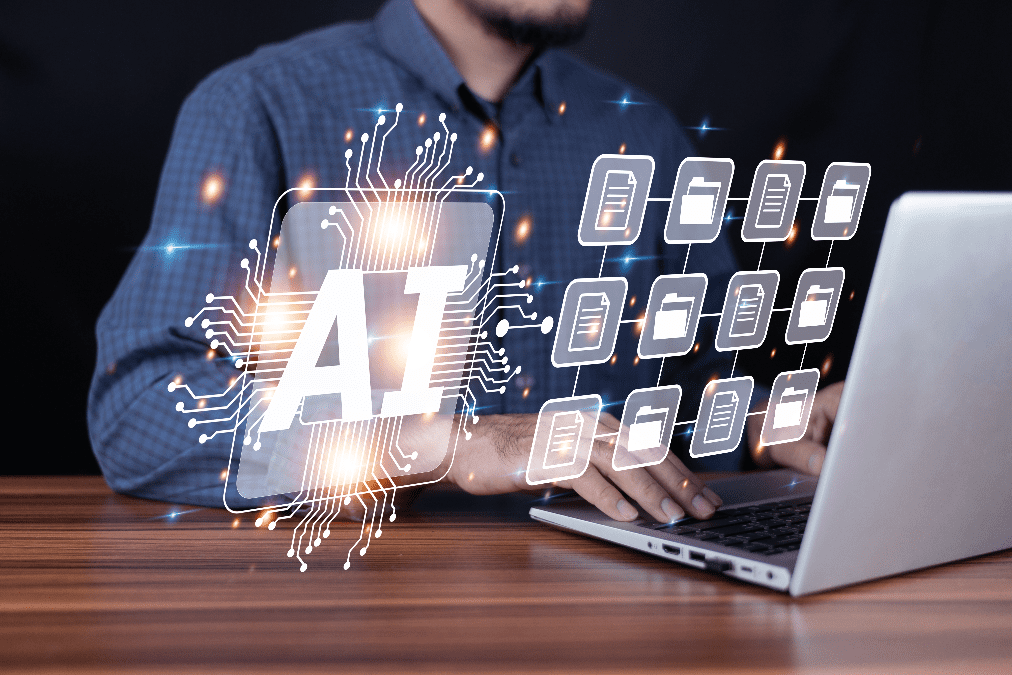The Present and Future of AI-Based Automation: A Roadmap for Business Leaders

AI-Based automation is not just a futuristic concept anymore, it’s happening right now, changing the way businesses operate. With its ability to quickly process vast amounts of data, make decisions, and adapt to changing scenarios, it is rapidly becoming a cornerstone of modern business operations. The value of this technology is evident in the fact that 80% of business leaders are planning to invest in AI initiatives by mid-2024. The wide spread adoption across business verticals is driving the global AI market, which is projected to expand at a CAGR of a whopping 37.3% from 2023 to 2030. Think about it: from chatbots that instantly address customer queries to automated financial tools, AI is everywhere.
Transformative Impact on Efficiency and Productivity
Consider this: remember when you had to manually rewind your cassette tapes? Painful, right? That’s how businesses without AI automation might feel in a few years. Imagine a world where manual, time-consuming tasks are a thing of the past. This isn’t a distant dream but a reality, thanks to AI automation. By replacing repetitive tasks with intelligent machines, businesses are achieving unprecedented levels of efficiency and productivity. But how? Let’s dive in.
Current Landscape of AI Automation Technologies
AI-Based Automation has seen rapid advancements in recent years. From rudimentary rule-based systems to intricate neural networks and deep learning models, the AI evolution has been phenomenal. Today, technologies like Machine Learning (ML), Natural Language Processing (NLP), and Robotics Process Automation (RPA) are integral components of the AI automation landscape. With the rise of cloud computing and accessible AI tools, even small businesses are jumping on the automation bandwagon. A deeper understanding of the underlying technologies will offer insight into their vast capabilities and applications in our daily lives.
Machine Learning (ML): Machine Learning is a subset of AI that focuses on the development of algorithms that enable machines to learn and make decisions from data without being explicitly programmed. The underlying principle is simple: feed the system enough data, and it will learn to discern patterns, making predictions or decisions based on its learning.
Applications of ML in Automation:
- Predictive Analytics: By analyzing vast amounts of data, ML can help identify not just existing trends and patterns but future possibilities. This application has proven helpful in education to predict student grades and ensure timely and strategic intervention to prevent failure and dropouts. A study of a 5 algorithm-based ML model demonstrated that it could predict the employability of IT graduates with 100% accuracy!
- Fraud Detection: From financial to education institutions and every other business in between, ML can be invaluable in detecting anomalies in customer behavior, identifying potentially fraudulent activities or risk of data breaches.
- Customer Recommendations: E-commerce platforms like Amazon and OTT providers like Netflix are using ML to recommend products or content based on user behavior. For finance, education, and medicine, predictive analytics can transform product development, learning delivery, journey curation, and diagnostics.
Natural Language Processing (NLP): Natural Language Processing pertains to the interaction between computers and humans through natural language. Already, 47% of organizations are using NLP to ensure compliance with data protection regulations and interact with customers. The ultimate goal is to read, decipher, understand, and generate human-like content in a manner that is both valuable and meaningful.
Applications of NLP in Automation:
- Chatbots: They use NLP to interpret and respond to user queries in natural language.
- Sentiment Analysis: Businesses analyze customer feedback to determine overall sentiment towards products or services for strategic decision making.
- Automated Transcription: Tools like Otter.ai transcribe spoken content into written text using NLP.
Robotic Process Automation (RPA): RPA involves automating rule-based tasks in business processes. Instead of traditional IT automation, which requires intricate scripting, RPA allows employees to configure “software robots” to capture and interpret the actions of existing applications. TD Ameritrade, Inc. Integrated AI for automating workflows to transform customer experience. The company succeeded in reducing customer onboarding time by up to 70%.
Applications of RPA in Automation:
- Data Entry: Automation of repetitive data entry tasks.
- Invoice Processing: Automatic extraction and processing of information from invoices.
- Customer Onboarding: Automating the initial steps when customers sign up for a service.
Deep Learning: Deep Learning is a subset of ML inspired by the structure of the human brain, specifically neural networks. It uses multiple layers of algorithms to process data, extract features, and make decisions.
Applications of Deep Learning in Automation:
- Image Recognition: Platforms like Google Photos identify and categorize images based on their content.
- Voice Assistants: Devices like Amazon’s Alexa use deep learning to understand and process voice commands.
- Medical Diagnosis: Medical imagery can be analyzed to detect diseases or anomalies.
Cloud-Based AI Services: With advancements in cloud computing, AI services have become more accessible. Companies don’t need to host expensive infrastructure anymore; they can tap into powerful AI capabilities on the cloud, scaling up or down as needed. This is why 67% of businesses are powering their AI initiatives via cloud technologies.
Applications of Cloud-Based AI:
- Data Storage and Analysis: Platforms like AWS and Google Cloud offer vast storage solutions combined with AI-powered data analytics tools.
- Training AI Models: Without investing in high-end hardware, businesses can utilize cloud platforms to train their AI and ML models.
- AI-Powered APIs: Many cloud providers offer APIs for vision, speech, and translation services, making it easier for businesses to integrate AI capabilities into their applications.
Real-World Examples Across Industries Companies across sectors are reaping the benefits of AI-based automation.
Retail: AI empowers retailers to boost market efficiency with targeted campaigns, optimize inventory management, and provide personalized customer services. Accenture reported that AI-powered solutions could increase profitability rates by 59% by 2035.
Amazon Go is a chain of convenience stores introduced by Amazon where there are no cashiers. Customers walk in, grab what they want, and walk out without any checkout process. The system recognizes what items have been taken using a mixture of computer vision, sensor fusion, and deep learning techniques.
Finance: Compliance and risk management are the two most crucial tasks in the finance sector. AI can dramatically improve KYC, AML and regulatory compliance, while also enabling the monitoring of transactions in real-time. Further, analysis of historical data, market trends, and borrower behaviors can drive lending decisions and reduce the likelihood of financial loss due to fraud.
JPMorgan Chase employs AI tools for contract analysis, reducing manual review time. COiN is a machine learning tool developed by JPMorgan that helps in analyzing legal documents and extracting essential data points and clauses.
Transport: From traditional automakers to tech giants, companies are investing heavily in self-driving technology. The primary motivators include safety, fuel efficiency, and potential cost savings in the logistics and taxi industries. Sustainable and efficient use of land and air transport are becoming increasingly vital for decision-making in mobility technologies.
In London, AI is applied to predict traffic flow and disruptions in road transport, while train operators use AI-powered simulators to check train paths, platforms, and schedules. The Network rail also claims that AI-powered automation has helped create safer and more efficient inspection regimes. In retail transport, Tesla’s autopilot system is a perfect example of automation in vehicular technology that can disrupt logistics.
Advantages and Benefits of AI-Based Automation
Efficiency and Cost Savings
- Streamlining Repetitive Tasks: By handling tasks such as data entry and routine customer queries, AI automation reduces human error and frees up employees for more value-added activities. The result? Faster processes, fewer mistakes, and significant cost savings.
- Potential for Increased Productivity: 73% of businesses experience the highest impact of AI-powered automation in boosting the time taken to profitability, cost reduction, and improved productivity. By operating round the clock, AI systems ensure that businesses remain productive even outside of regular working hours. This constant operation boosts output and allows for quick scalability.
Enhanced Decision-Making
- Data-Driven Insights: Remember the times when business decisions were made based on gut feelings? Those days are becoming a thing of the past, as AI brings actionable insights from vast data sources, ensuring that decisions are informed and effective. Whether it’s predicting market trends or identifying potential risks, AI’s got it covered. Microsoft Security Copilot is one such application that relies on AI for security analysis. IT enables security personnel to evaluate risk exposure almost instantaneously and empowers them to respond quickly to threats.
- Role of AI in Big Data Analysis: The ability of AI to sift through vast datasets and identify patterns humans might miss is unparalleled. This means businesses can detect emerging trends, assess risks, and discover new opportunities faster than ever.
Improved Customer Experience
- AI in Customer Interactions: Ever interacted with a chatbot and felt like you were talking to a human? That’s AI at work! Companies are leveraging AI to enhance customer service, ensuring queries are addressed promptly and efficiently. By 2025, 75% of customer interactions are expected to be driven by AI, a figure that could reach up to 95% in the following 5 years. Customer satisfaction and risk management come in a close second, with 72% of businesses considering them the business functions that benefit the most.
- Personalized Services with AI Chatbots: Gone are the days of one-size-fits-all. AI chatbots offer personalized responses based on user behavior and preferences, ensuring a tailored and delightful experience for every customer.
Industries and Use Cases for AI-Based Automation
- Manufacturing and Robotics
- AI-Driven Robotics in Production: Robots, powered by AI, are now common sights in factories. They handle tasks from welding and assembly to packaging, improving precision and reducing accidents.
- Smart Factories and Automated Assembly: Consider the “lights-out” factories, where robots do all the work in the dark because they don’t need lights! Such levels of automation are revolutionizing manufacturing.
- Finance and Accounting
- AI in Fraud Detection and Invoice Processing: Financial fraud is a pressing concern, but AI tools, with their pattern recognition abilities, are game changers in detecting suspicious activities. Additionally, tasks like invoice processing, once considered tedious, are now automated, ensuring accuracy and efficiency.
- Benefits of AI-Driven Financial Analysis: With AI’s ability to analyze vast amounts of financial data, businesses can gain insights into market trends, investment opportunities, and risk factors like never before.
- Customer Service and Support
- AI Chatbots and Virtual Assistants: The next time you’re greeted by a customer service chatbot, remember, it’s a sophisticated AI system handling your query, ensuring quick and accurate responses.
- Routine Inquiry Handling: For general queries or frequently asked questions, AI systems offer instant solutions, freeing up human agents for more complex issues.
- Healthcare and Medical Applications
- AI in Medical Imaging and Diagnosis: AI tools, by analyzing medical images, can detect anomalies that might be missed by the human eye. This leads to quicker and more accurate diagnoses.
- AI’s Role in Patient Care: From personalized treatment plans to automated medication reminders, AI ensures patients receive optimum care tailored to their unique needs.
The Future of AI-Based Automation
Emerging Trends and Innovations
Advancements in Neural Networks and Deep Learning: As AI systems become more sophisticated, we can expect further advancements in deep learning and neural networks, pushing the boundaries of what’s possible.
Increased Integration with IoT: With the proliferation of Internet of Things (IoT) devices, AI’s role will expand in managing and analyzing the vast data these devices generate.
Challenges and Ethical Considerations
Job Displacement Concerns: While AI automates tasks and improves efficiency, there’s growing concern about job losses. The challenge is to ensure a balance, where AI aids human work rather than replaces it.
Data Privacy and Security: As AI systems handle vast amounts of data, concerns about data privacy and potential breaches are on the rise. Ensuring robust security measures will be crucial.
Roadmap for Business Leaders Embracing the full potential of AI-based automation is no longer an option—it’s a necessity for companies aiming to stay competitive. As a business leader, implementing AI is not just about technology; it’s about driving change throughout the organization. Here’s a roadmap to guide this transformative journey:
Assessing Automation Opportunities:
- Identify Pain Points: Before deploying AI solutions, recognize areas in your business processes that are repetitive, time-consuming, or error-prone. These are prime candidates for automation.
- Evaluate ROI: Not all automation opportunities are created equal. Assess the potential return on investment (ROI) for each identified area. Focus on projects that offer significant cost savings, revenue generation, or strategic advantage.
- Prioritize Implementation:
Start with low-hanging fruit—areas where automation can be easily implemented and deliver quick wins. This will build momentum for larger, more complex projects.
Building an AI-Ready Workforce:
- Upskilling and Reskilling: Invest in training programs to equip your existing workforce with the skills needed to work alongside AI tools. This includes understanding AI basics, data interpretation, and decision-making in an AI-augmented environment.
- Hiring and Talent Acquisition: As the demand for AI expertise grows, prioritize hiring individuals with experience in data science, machine learning, and other AI disciplines.
- Foster a Culture of Continuous Learning:
AI and its applications are continuously evolving. Encourage a mindset of lifelong learning and adaptability among employees.
Integrating AI Automation:
- Choose the Right Tools: Based on your company’s unique needs and the automation opportunities identified, choose AI tools and platforms that align with your goals.
- Collaborate with IT: Ensure a strong partnership between your IT department and other business units. This ensures the technical feasibility of AI projects and smooth integration into existing systems.
- Test and Iterate:
Implement AI solutions in stages. Start with pilot projects, gather feedback, refine the process, and then scale. This iterative approach reduces risks and ensures maximum efficiency.
- Ethical Considerations:
As you integrate AI automation, be mindful of ethical implications. This includes bias in AI algorithms, transparency in decision-making, and the potential societal impacts of automation.
The world of AI-based automation is vast and ever-evolving. Its potential to transform businesses is undeniable, but it also brings challenges that leaders must navigate. For now, only 15% of organizations have effectively deployed AI capabilities in practice, despite huge investments. However, by understanding its implications and strategically integrating AI into operations, businesses can not only stay ahead of the curve but also pave the way for a future where technology and human ingenuity work hand in hand. Contact Integra to learn more about leveraging AI to transform your business.
Recent Blogs

AI-Supported Pedagogy Has Arrived. Now Comes the Content Reckoning.



